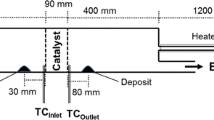Abstract
In this study, the effect of hydrothermal aging over a commercial diesel oxidation catalyst (DOC) on deterioration in nitrogen dioxide (NO2) production activity has been experimentally investigated based on a micro-reactor DOC experiment. Through this experimental result, the NO2 to nitrogen oxides (NOx) ratio at DOC outlet has been mathematically expressed as a function of DOC temperature according to various aging conditions. The current study reveals that the catalyst aging temperature is a more dominant factor than the aging duration in terms of the decrease in NO2 production performance through DOC. The DOC sample hydrothermally aged for 25 h at 750 °C has displayed the lowest NO2 to NOx ratio compared to the samples aged for 25 ~ 100 h at 650 °C. Also, in this study, the impact of hydrothermal aging of a DOC on the selective catalytic reduction (SCR) efficiency in a ‘DOC + SCR’ aftertreatment system was predicted by using transient SCR simulations. To validate the SCR simulation, this study has conducted a dynamometer test of a non-road heavy-duty diesel engine with employing a commercial ‘DOC + SCR’ system on the exhaust line. The current study has quantitatively estimated the effect of the variation in NO2 to NOx ratio due to the hydrothermal aging of DOC on the NOx removal efficiency of SCR.
Similar content being viewed by others
Abbreviations
- C i :
-
coefficients for curve fit, non-dimensional
- T :
-
temperature, °C
- y :
-
NO2 to NOx ratio, %
References
Allansson, R., Cooper, B. J., Thoss, J. E., Uusimäki, A., Walker, A. P. and Warren, J. P. (2000). European experience of high mileage durability of continuously regenerating diesel particulate filter technology. SAE Paper No. 2000–01-0480.
Bai, S., Tang, J., Wang, G. and Li, G. (2016). Soot loading estimation model and passive regeneration characteristics of DPF system for heavy-duty engine. Applied Thermal Engineering, 100, 1292–1298.
Brijesh, P. and Sreedhara, S. (2013). Exhaust emissions and its control methods in compression ignition engines: a review. Int. J. Automotive Technology 14, 2, 195–206.
Choi, B. C. and Foster, D. E. (2006). Overview of the effect of catalyst formulation and exhaust gas compositions on soot oxidation in DPF. J. Mechanical Science and Technology 20, 1, 1–12.
Dan, H. and Lee, J. (2016). Modeling and measurement of boiling point elevation during water vaporization from aqueous urea for SCR applications. J. Mechanical Science an d Technology 30, 3, 1443–1448.
Devadas, M., Kröcher, O., Elsener, M., Wokaun, A., Söger, N., Pfeifer, M., Demel, Y. and Mussmann, L. (2006). Influence of NO2 on the selective catalytic reduction of NO with ammonia over Fe-ZSM5. Applied Catalysis B: Environmental 67, 3–4, 187−196.
Dhillon, P. S., Harold, M. P., Wang, D., Kumar, A. and Joshi, S. (2017). Hydrothermal aging of Pt/Al2O3 monolith: Washcoat morphology degradation effects studied using ammonia and propylene oxidation. Catalysis Today, DOI: https://doi.org/10.1016/j.cattod.2017.12.023.
Dosda, S., Berthout, D., Mauviot, G. and Nogre, A. (2016). Modeling of a DOC SCR-F SCR exhaust line for design optimization taking into account performance degradation due to hydrothermal aging. SAE Int. J. Fuels and Lubricants 9, 3, 621–632.
Emission Test Cycles; Nonroad Transient Cycle (2018). https://www.dieselnet.com/standards/cycles/nrtc.php
Hirata, K., Masaki, N., Yano, M., Akagawa, H., Takada, K., Kusaka, J. and Mori, T. (2009). Development of an improved urea-selective catalytic reduction-diesel particulate filter system for heavy-duty commercial vehicles. Int. J. Engine Research 10, 5, 337–348.
Jääskeläinen, H. and Khair, M. K. (2018). https://www.dieselnet.com/tech/diesel_engines.php
Jääskeläinen, H. and Majewski, W. A. (2018). https://www.dieselnet.com/tech/engine_heavy-duty_ aftertreatment.php
Johnson, T. (2016). Vehicular emissions in review. SAE Int. J. Engines 9, 2, 1258–1275.
Johnson, T. and Joshi, A. (2017). Review of vehicle engine efficiency and emissions. SAE Paper No. 2017–01-0907.
Ko, A., Kim, J., Choi, K., Myung, C. L., Kwon, S., Kim, K., Cho, Y. J. and Park, S. (2012). Experimental study of particle emission characteristics of a heavy-duty diesel engine and effects of after-treatment systems: Selective catalytic reduction, diesel particulate filter, and diesel particulate and NOx reduction. Proc. Institution of Mechanical Engineers, Part D: J. Automobile Engineering 226, 12, 1689–1696.
Koebel, M., Elsener, M. and Madia, G. (2001). Reaction pathways in the selective catalytic reduction process with NO and NO2 at low temperatures. Industrial & Engineering Chemistry Research 40, 1, 52–59.
Koebel, M., Madia, G. and Elsener, M. (2002). Selective catalytic reduction of NO and NO2 at low temperatures. Catalysis Today 73, 3–4, 239−247.
Majewski, W. A. (2018). https://www.dieselnet.com/tech/emi_intro.php
Nova, I. and Tronconi, E. (2014). Urea-SCR Technology for deNOx after Treatment of Diesel Exhausts. Springer. New York, USA.
Pfahl, U., Schatz, A. and Konieczny, R. (2012). Advanced exhaust gas thermal management for lowest tailpipe emissions–Combining low emission engine and electrically heated catalyst. SAE Paper No. 2012–01-1090.
Wang, T. J., Baek, S. W., Kwon, H. J., Kim, Y. J., Nam, I. S., Cha, M. S. and Yeo, G. K. (2011). Kinetic parameter estimation of a commercial Fe-zeolite SCR. Industrial & Engineering Chemistry Research 50, 5, 2850–2864.
Wang, T. J., Kim, D. S. and Ahn, T. S. (2017). Simulation study on improving the selective catalytic reduction efficiency by using the temperature rise in a non-road transient cycle. Proc. Institution of Mechanical Engineers, Part D: J. Automobile Engineering 231, 6, 810–827.
Xi, Y., Ottinger, N. A. and Liu, Z. G. (2013). Effect of hydrothermal aging on the catalytic performance and morphology of a vanadia SCR catalyst. SAE Paper No. 2013–01-1079.
Author information
Authors and Affiliations
Corresponding author
Rights and permissions
About this article
Cite this article
Wang, T.J. Effect of Hydrothermal Aging over a Commercial DOC on NO2 Production and Subsequent SCR Efficiency. Int.J Automot. Technol. 19, 941–947 (2018). https://doi.org/10.1007/s12239-018-0091-3
Received:
Revised:
Accepted:
Published:
Issue Date:
DOI: https://doi.org/10.1007/s12239-018-0091-3




